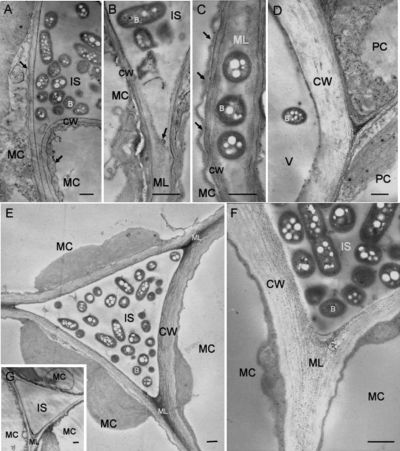Ralstonia solanacearum: Difference between revisions
| Line 59: | Line 59: | ||
[[Image:Ralstonia_on_tobacco_leaves.jpg]] | [[Image:Ralstonia_on_tobacco_leaves.jpg]] | ||
caption: Electron micrographs showing tobacco leaf tissues at 3 days after infiltration with R. solanacearum. (9) | |||
==Application to Biotechnology== | ==Application to Biotechnology== | ||
Revision as of 22:59, 20 August 2007
A Microbial Biorealm page on the genus Ralstonia solanacearum
Classification
Higher order taxa
Bacteria; Proteobacteria; Beta Proteobacteria; Burkholderiales; Ralstoniaceae [Others may be used. Use NCBI link to find]
Species
|
NCBI: Taxonomy |
Ralstonia solanacearum
Description and significance
Describe the appearance, habitat, etc. of the organism, and why it is important enough to have its genome sequenced. Describe how and where it was isolated. Include a picture or two (with sources) if you can find them.
<a href="http://photobucket.com" target="_blank"><img src="http://i8.photobucket.com/albums/a40/dangitscam2/Ralstonia.jpg" border="0" alt="Photo Sharing and Video Hosting at Photobucket"></a> (3)
Ralstonia solanacearum is a plant pathogenic bacterium. This organism causes bacterial wilts and infection of over 200 plants species. It is usually found in soils of tropical and subtropical countries. This pathogen can lie dormant in water or soil until a host plant grows. Once the host begins to develop, the organism spreads throughout the plant by entering the roots and colonizing water-conducting vessels.(1)
Through genome sequencing, we observe that the genome encodes many proteins potentially associated with a role in pathogenicity. In particular, many putative attachment factors were identified. (2) The analysis of the genome has made it possible to identify more than 200 new genes that are potentially involved in virulence. (4)
Genome structure
Describe the size and content of the genome. How many chromosomes? Circular or linear? Other interesting features? What is known about its sequence? Does it have any plasmids? Are they important to the organism's lifestyle?
R. solanacearum genome into two circular molecules: a large replicon of 3,716,413 bp and a smaller 2,094,509-bp replicon, yielding a total genome size of 5,810,922 bp. The two molecules have an almost identical G+C content (67.04% and 66.86% for the large and small replicon, respectively).(5) The genome encodes many proteins potentially associated with a role in pathogenicity.
Cell structure and metabolism
Describe any interesting features and/or cell structures; how it gains energy; what important molecules it produces.
Ralstonia solanacearum is a Gram negative pathogen. It has an outer membrane and inner membrane. Its cell walls consist of peptidoglycan.(6)
The plant pathogen Ralstonia solanacearum needs aerotaxis for normal biofilm formation. In order to locate and infect host plant roots, R. solanacearum needs taxis, the ability to move towards more favorable conditions. Aerotaxis, or energy taxis, which guides bacteria toward optimal intracellular energy levels. The energy taxis contributes significantly to the ability of R. solanacearum to locate and effectively interact with its host plants.(7)
It is known to produce a potent L-fuctose-binding lectin, RSL, a small protein of 90 amino acids with a tandem repeat in its amino acid sequence. The RSL forms a trimer which produces a six-bladed Beta-propellor. Host plant cell walls contain carbohydrates which enable attachment sites for the pathogen protein receptors. In this case, the lectin has a great affinity for αFuc1-2Gal and αFuc1-6Gal epitopes found on certain plants. (6)
Ecology
Describe any interactions with other organisms (included eukaryotes), contributions to the environment, effect on environment, etc.
Ralstonia solanacearum is commonly found in the soils of tropical and subtropical countries where it devastates cultures of many crop plants. Certain strains are adapted to milder environmental conditions and have recently been isolated in northern European countries. Major agricultural hosts include tobacco, tomato, potato, eggplant, pepper and banana trees.(1) This bacterium can also be free-living as a saprophyte in water or in the soil in the absence of host plants. (8)
Pathology
How does this organism cause disease? Human, animal, plant hosts? Virulence factors, as well as patient symptoms.
R. solanacearum</>i possesses hrp encoding the type III secretion system (T3SS), and its pathogenicity depends on interactions between the host plant and type III effectors. R. solanacearum invades intercellular spaces of roots
through openings such as wounds then accumulates around the stele before breaking into and filling the xylem vessels. On invasion of the xylem vessels, the bacteria grow and travel rapidly to the upper parts of the plant. This results in extensive wilting because of reduced sap flow caused by the presence of a large number of bacteria cells and exopolysaccharide
(EPS) slime produced by the bacteria in some xylem vessels. The main virulence factor of R. solanacearum is therefore thought to be EPS.(9)
R. solanacearum also produces several known virulence factors including a consortium of plant cell wall-degrading enzymes (CWDEs), which are secreted via the type II secretion system (T2SS).
 caption: Electron micrographs showing tobacco leaf tissues at 3 days after infiltration with R. solanacearum. (9)
caption: Electron micrographs showing tobacco leaf tissues at 3 days after infiltration with R. solanacearum. (9)
Application to Biotechnology
Does this organism produce any useful compounds or enzymes? What are they and how are they used?
Current Research
Enter summaries of the most recent research here--at least three required
References
Edited by student of Rachel Larsen
